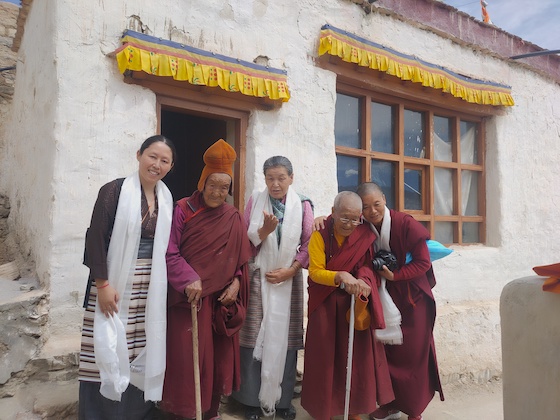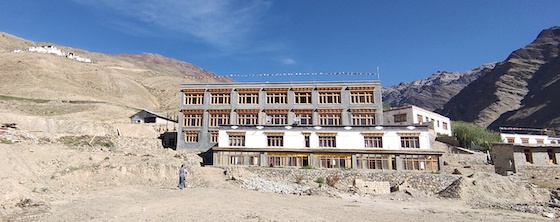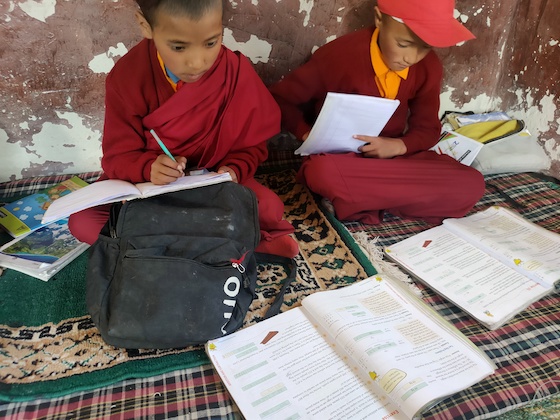In the remote Indian Himalayas lies a 700-year-old Tibetan Buddhist nunnery called Dorjee Zong. The nunnery has a long tradition of meditating nuns, some of who are famed for having reached high levels of realization.
Dorjee Zong is one of seven nunneries supported by the Tibetan Nuns Project. During the pandemic, this remote nunnery was even more cut off than usual.
In August 2022, a team from the Tibetan Nuns Project office near Dharamsala travelled for several days over hazardous roads from Leh to Zanskar. The team wanted to check on the nuns’ welfare and the progress of various projects at the nunnery including the major construction project started in 2019.

Nangsa Choedon, Director of the Tibetan Nuns Project in India (middle), Tsering Diki, Assistant Director (left), and Delek Yangchen, one of the Dolma Ling media nuns (right) with the two eldest nuns at Dorjee Zong. These two nuns are both 90 years old.
For over 12 years the Tibetan Nuns Project has been helping this small nunnery with sponsorship of the nuns, teacher salaries, and a big construction project to improve all facilities at the nunnery.
Here’s a video of their visit. Can’t see video? Click here.

The old part of Dorjee Zong is on the hilltop on the left and the new school and other parts of the nunnery are lower down. The pandemic and the short building season at this high altitude have posed challenges.
Dorjee Zong is home to 20 nuns – 13 young nuns and 7 elder nuns. The oldest two are both 90-years-old. The seven elder nuns live at the ancient nunnery on the hill top. They spend most of their time reciting mantras and circumambulating the sacred site. They also take care of their field and greenhouse to stock up supplies for the harsh winters. The younger nuns live and study in the lower and newer part of the nunnery.

The old traditional kitchen at Dorjee Zong Nunnery. The nunnery is one of the oldest centers in pursuit of monastic education in Zanskar.
Girls in the Himalayas are generally given far less education than boys. Girls are often removed from school as early as grade 4, if they are sent at all. The nunnery educates both lay girls and nuns. It gives them a chance for education that they would not otherwise have.

Math class. Lay girls and young nuns study at the nunnery up to Grade 5 after which they take the TNP-funded school bus 6 miles to continue their education.
Girls study up to Grade 5 at the nunnery, after which they travel by school bus for further schooling. The school bus was funded in 2019 by Tibetan Nuns Project donors and is also helping children from the local village attend school.
Construction Project Update
With the support of generous Tibetan Nuns Project donors, the nunnery embarked on an ambitious project to improve all the facilities for the nuns — an important and exciting transition for this ancient nunnery.
Construction started in 2019, but the work has been hampered by the pandemic. Also, the long severe winters and remote location reduce the construction window to around five months.

Nuns’ quarters in the new housing block at Dorjee Zong. Before 2019, the buildings at this 700-year-old nunnery were very basic. There was just one classroom and one main building that was used for everything.
The two-story hostel is finished! The ground floor is now being used as students’ quarters, sufficient for the current number of students. The top floor is being used as the school office, dining hall, staff quarters, and meeting room. Once other facilities are complete, the entire building will be used to accommodate future students.

The new dining hall. In 2019, thanks to generous donors, the nunnery began a major construction project to improve all the facilities for the nuns.
The three-story kitchen and prayer hall building is coming along very well. The ground floor has a big dining hall which will, in future, be used by students, staff, and teachers. The dining hall is designed in local style with mats and low tables. However, they also plan to set up some tables and chairs for visitors.

Prayers before breakfast. The nunnery has two cooks who prepare meals for all residents at the school. The food is healthy and vegetarian.
The first floor has a hall to be used for prayers, workshops, meetings, and teachings. This hall will also be decorated in the local style. Opposite there will be a library and computer room for the students. Six computer desks have already been made and will accommodate two per table. The library’s wooden book shelves will also serve as a room divider.

One of the bright new classrooms being built. In the past, the nuns at Dorjee Zong did not have the opportunity to engage in rigorous studies, but their education program is improving.
According to the original plans, the nunnery was to have separate school blocks, staff blocks, and office blocks. Now, instead of building separate blocks, the construction committee decided to add a second floor onto the existing building. It is more cost effective and will also be warmer; there were not any other sunny building locations.

The side of a new building at Dorjee Zong showing the traditional carpentry work for the windows and doors.
The nuns have been able to get a water connection with the help of the local government. This is very beneficial for the elder nuns as well as for the school. A water storage tank is being set up at the nunnery and the nuns’ committee will see what else needs to be done.

This photo of Dorjee Zong Nunnery was taken prior to the expansion project started in 2019. Photo courtesy of Olivier Adam.
Thank you so much for your support of the nuns!

Thank you so much for sharing such wonderful work and place. Long may the support and restoration of places of learning continue and the Dharma flourish for all sentient beings. Thank you.
Marvelous!
So wonderful to see these dedicated nuns of all ages getting support and attention so they may continue their studies and practice in good health and shelter🙏🏼May all beings benefit. Thank you for this beautiful video!
What is the altitude of the nunnery?
Do the children pay a tuition for their schooling?
Why not plant trees all around the new buildings?
Fascinating presentation. Thank you.
Dear Betty, Thank you for your comments. Dorjee Zong is at just under 4000 metres or 13,000 feet. The region of Zanskar is a high-altitude semi-desert lying on the northern flank of the Himalayan Range so not many tall trees grow in this climate. This mountain range acts as a barrier protecting Ladakh and Zanskar from most of the monsoon, resulting in a dry climate in the summer. Most of the precipitation occurs as snowfall during the harsh and extremely long winter period. These winter snowfalls are of vital importance, since they feed the glaciers which melt in the summer and provide most of the irrigation water. Much of Zanskar’s vegetation is found in the irrigated villages and until just recently, water for the nuns themselves has been an issue and the nuns are now getting a new water connection and water storage tank with the help of the local government.
As for schooling, the children are educated for free.
So beautiful to see a Buddhist monastic life being supported……peace, love, devotion, charity, what is needed to mend our damaged world. As for trees, perhaps access to water, elevation, and soil quality makes that prohibitive, The starkness reinforces the elements of simplicity and non attachment. So beautiful.
I always enjoy your beautiful emails, but this might be the best one yet!! What a tremendous presentation! Thank you so much!